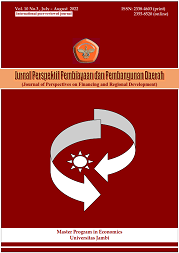Strategy in developing priority craft industry by using SAWSWOT Model in Jambi Province
DOI:
https://doi.org/10.22437/ppd.v10i5.16654Keywords:
Creative industry, Priority, Strategy, SAWSWOTAbstract
This study aims to determine the quality creative craft industry to be developed and to formulate a strategy for developing these priority creative industries. The analytical model used to determine the priority creative craft industry is the SAW (Simple Additive Weighting) model. The SAWSWOT model is used to formulate the priority creative industry development strategy. The result of the study shows that the batik industry has been selected as a priority creative craft industry. At the same time, the strategies that can be used to develop the batik industry are increasing IT mastery by management staff, workforce skills, using Jambi batik design applications, and marketing through E-Commerce.
Downloads
References
Ahmad, E., R.M Rachmad., Zamzami., & Delis, A. (2020). Downstream development strategy of processing industry in Jambi Province. Jurnal Perspektif Pembiayaan dan Pembangunan Daerah. 8(5), 497-508
Ardiana, F. (2020). Succes Factors for Small and Medium Industries Based on Creative Industries. Economics Development Analysis Journal, 9(1), 23-38
Asnawati, A., & Kanedi, I. (2015). Sistem Pendukung Keputusan Kenaikan Pangkat Karyawan Perseroan Terbatas Pelayaran Kumafa Lagun Marina Bengkulu. Jurnal Media Infotama, 8(1), 118 - 137
Boccella, N., & Salerno, L. (2016). Creative economy, cultural industries and local development. Procedia-social and Behavioral Sciences, 223. 291-296
Brouillette, S. (2020). Literature and the creative economy. Redwood City: Stanford University Press.
De Beukelaer,C. (2014). Creative Industries in “Developing†Countries. Questioning Country Classifications in the UNCTAD Creative Economy Reports. Cultural Trends, 23(4), 232-251
Fahmi, F.Z., Koster, S., & Djik, J. (2016). The Location of Creative Industries in a Developing Country: The case of Indonesia. Cities 59,66-79
Fahmi, F.Z., McCann, P.. & Koster, S. (2017). Creative economy policy in developing countries: The case of Indonesia, Urban Studies, 54(6), 1367–1384.
Fazlagic, J. & Skikiewicz, R. (2019) Measuring sustainable development the creative economy perspective. International Journal of Sustainable Development & World Ecology, 26(7), 635-645.
Fitriana, A.N., Noor, I. & Hayat, A. (2014). Pengembangan Industri Kreatif di Kota Batu (Studi tentang Industri Kreatif Sektor Kerajinan di Kota Batu). Journal of Public Administration. 2(2), 281-286
Gunday, G., Ulusoy, G., Kilic, K & Alpkan, L, (2011). Effects of innovation types on firm performance. International Journal of Production. Economics. 133 (2), 662–676
Hidayat, M,S & RM, Rachmad. (2019). Policy Analysis On Development Of Leading Creative Industry Products In Muara Bungo Regency. International Journal Of Scientific & Technology Research. 8(11), 1941-1944
Hotho, S., & Champion, K. (2011). Small Businesses in The New Creative industries: Innovation as a People Management Challenge. Management Decision, 49(1), 29-54
Kamil, A. (2015). Industri Kreatif Indonesia: Pendekatan Analisis Kinerja Industri. Media Trends. 10(2), 207-225
Departemen Perdagangan Republik Indonesia. (2007). Studi Industri Kreatif Indonesia. Jakarta: Departemen Perdagangan Republik Indonesia.
Lita, R. P., Meuthia, M., Faisal, R. F., & Surya, S. (2018). SME’s innovative performance in Indonesia: The linkage between innovation culture and production performance. International Journal of Supply Chain Management, 7(4), 242-253
Munthe, H.G. (2013). Sistem Pendukung Keputusan Penentuan Prioritas Usulan Sertifikasi Guru Dengan Metode Simple Additive Weighting. Pelita Informatics Budi Darma, 4(2), 52-58
Nasution, D.D. & Aminah, A.N. (2021). Sandiaga: Ekonomi Kreatif Penggerak Baru Ekonomi Dunia. https://www.republika.co.id/berita/r019c2384/sandiaga-ekonomi-kreatif-penggerak-baru-ekonomi-dunia
Pradhan, R.P., Arvin,M.B., Nair, M. & Bennett, S.E. (2020). The dynamics among entrepreneurship, innovation, and economic growth in the Eurozone countries, Journal of Policy Modeling, 42(5), 1106-1122,
Satria, D & Prameswari, A. (2011). Creative Industry Development Strategy To Increase The Competitiveness of Local Economic Actors. Journal of Management Applications. 9 (1). 301-308
Tuech, J. J., Gangloff, A., Di Fiore, F., Michel, P., Brigand, C., Slim, K., ... & Schwarz, L. (2020). Strategy for the practice of digestive and oncological surgery during the Covid-19 epidemic. Journal of visceral surgery, 157(3), S7- S12. https://doi.org/10.1016/j.jviscsurg.2020.03.008
Yuvanda, S., R,M, Rachmad., Zamzami, Z & Syari,M. (2020). Development on The Leading Small and Medium-Sized Industry (SMI): Food Industry in Jambi Province. Perspectives on Financing and Regional Development, 9(3), 311-318
Zhou, X., Cai, Z. Tan, K.H., Zhang, L., Du, J. & Song, M. (2021). Technological innovation and structural change for economic development in China as an emerging market, Technological Forecasting and Social Change, 167, 120671,
Zhang, D., Hu, M., & Ji, Q. (2020). Financial markets under the global pandemic of COVID-19. Finance Research Letters, 36, 101528. https://doi.org/10.1016/j.frl.2020.101528
Downloads
Published
How to Cite
Issue
Section
License
Copyright (c) 2022 Sesraria Yuvanda, M. Rachmad R., M. Syurya Hidayat

This work is licensed under a Creative Commons Attribution 4.0 International License.

















